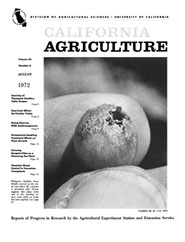


University of California
California Agriculture



|
|||
|
|||

Cover:
Thompson Seedless berry heavily scarred at the stylar end where the calyptra is persistent after bloom, suggests this plays some role in the scarring injury - even when no spray has been applied.
August 1972
Volume 26, Number 8 News and opinion |
|||
|
University of California, 1301 S. 46th St., Bldg. 478 Richmond, CA
|